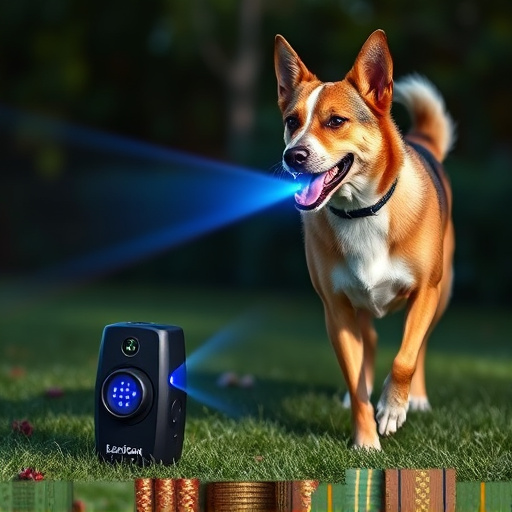Safe ultrasonic frequencies target specific dog behaviors above 23 kHz without harm. These devices guide training with signals perceivable by dogs, encouraging or discouraging actions like barking or pulling. Prioritizing safe ultrasonic frequencies ensures humane, effective behavior modification, fostering trust and a positive bond with canine companions. Choose devices emitting approved frequencies for harmless, reliable control.
Dogs, like humans, respond to different stimuli. One innovative tool in dog training is the ultrasonic behavior modifier, a device that utilizes high-frequency sound waves to guide canine behavior. This article delves into the science behind these modifiers, focusing on safe ultrasonic frequencies as a key to effective training. We explore integration of safety measures for both dog welfare and control, ensuring responsible use of this modern training aid. Understanding these principles is crucial for navigating the world of safe ultrasonic frequencies for dog control.
- Understanding Ultrasonic Behavior Modifiers for Dogs
- Safe Frequency Range: A Key to Effective Training
- Integrating Safety Measures for Dog Welfare and Control
Understanding Ultrasonic Behavior Modifiers for Dogs
Ultrasonic behavior modifiers are devices that use specific high-frequency sounds, usually beyond human hearing range, to communicate with dogs. These safe ultrasonic frequencies can be used to guide and train canine behavior, offering a humane alternative to traditional positive reinforcement methods. The technology works by emitting a sound that dogs perceive as a signal, encouraging or discouraging certain actions.
When it comes to dog training, understanding the safe ultrasonic frequencies is key. These devices are designed to emit sounds within a range that’s harmless to dogs, typically between 23-25 kHz. This high frequency ensures it doesn’t cause physical harm or discomfort, making it an effective yet gentle tool for modifying behavior. By targeting specific behaviors like barking, jumping, or pulling on leashes, ultrasonic modifiers can help train dogs in a way that enhances their learning experience.
Safe Frequency Range: A Key to Effective Training
When considering a dog training ultrasonic behavior modifier, one of the most critical factors is understanding and utilizing safe ultrasonic frequencies for dog control. These devices emit high-frequency sound waves that are inaudible to humans but can be effectively used to guide canine behavior. However, not all ultrasonic frequencies are created equal; employing safe and appropriate ranges is essential for both effectiveness and the well-being of your pet.
Using safe ultrasonic frequencies ensures that the training process remains humane and non-harmful to your dog’s sensitive hearing. Frequencies should be set within a range that is known to be effective in modifying behavior without causing discomfort or any form of injury. By carefully selecting and adhering to these safe parameters, you can effectively train your canine companion while maintaining a strong bond built on trust and positive reinforcement.
Integrating Safety Measures for Dog Welfare and Control
When utilizing ultrasonic behavior modifiers, ensuring dog safety is paramount. It’s crucial to choose devices that emit safe ultrasonic frequencies designed specifically for canine control. These frequencies are tailored to be inaudible to humans but effective in capturing a dog’s attention, making them a humane alternative to traditional, often stressful, training methods.
Using the wrong frequency or an untargeted device can lead to unnecessary stress and even harm. Reputable manufacturers adhere to strict guidelines for safe ultrasonic levels, ensuring these devices are not only effective but also harmless when used as directed. Always follow the manufacturer’s instructions and consult with a professional trainer or veterinarian to confirm the safety and suitability of any ultrasonic behavior modifier for your dog.
Ultrasonic behavior modifiers have emerged as a innovative tool for dog training, offering safe and effective methods to guide canine behavior. By understanding and leveraging specific ultrasonic frequencies within the optimal safe range, trainers can positively reinforce desirable actions while minimizing potential harm. Integrating these safety measures ensures responsible dog welfare and control, making ultrasonic devices a valuable asset in modern pet training practices. Adopting safe ultrasonic frequencies for dog control allows for effective communication with our furry companions without compromising their well-being.
